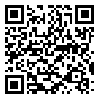1. Lin C, Braund WE, Auerbach J, Chou J-H, Teng J-H, Tu P, et al. Policy decisions and use of information technology to fight coronavirus disease, Taiwan. Emerg Infect Dis. 2020;26(7):1506-12. [
DOI:10.3201/eid2607.200574]
2. Yip W, Fu H, Chen AT, Zhai T, Jian W, Xu R, et al. 10 years of health-care reform in China: Progress and gaps in universal health coverage. Lancet. 2019;394(10204):1192-204. [
DOI:10.1016/S0140-6736(19)32136-1]
3. Hossain A, Quaresma R, Rahman H. Investigating factors influencing the physicians' adoption of electronic health record (EHR) in healthcare system of Bangladesh: An empirical study. Int J Inf Manage. 2019;44:76-87. [
DOI:10.1016/j.ijinfomgt.2018.09.016]
4. Tamjid S, Rezaei Sharifabadi S. Study of effective usage of information technology by residents in Iran University of Medical Sciences. Journal of Health Administration. 2010;13(40):23-30. [In Persian]
5. Gardner RL, Cooper E, Haskell J, Harris DA, Poplau S, Kroth PJ, et al. Physician stress and burnout: The impact of health information technology. J Am Med Inform Assoc. 2019;26(2):106-14. [
DOI:10.1093/jamia/ocy145]
6. Aceto G, Persico V, Pescape A. Industry 4.0 and health: Internet of things, big data, and cloud computing for healthcare 4.0. J Ind Inf Integr. 2020;18:1-13. [
DOI:10.1016/j.jii.2020.100129]
7. Gopal G, Suter-Crazzolara C, Toldo L, Eberhardt W. Digital transformation in healthcare-architectures of present and future information technologies. Clin Chem Lab Med. 2019;57(3):328-35. [
DOI:10.1515/cclm-2018-0658]
8. Wu J, Guo S, Huang H, Liu W, Xiang Y. Information and communications technologies for sustainable development goals: State-of-the-art, needs and perspectives. Communications Surveys and Tutorials, IEEE. 2018;20(3):2389-406. [
DOI:10.1109/COMST.2018.2812301]
9. Aceto G, Persico V, Pescape A. The role of information and communication technologies in healthcare: Taxonomies, perspectives, and challenges. J Netw Comput Appl. 2018;107:125-54. [
DOI:10.1016/j.jnca.2018.02.008]
10. Wager KA, Lee FW, Glaser JP. Health care information systems: A practical approach for health care management. 2nd ed. United States: John Wiley & Sons; 2009.
11. Moghaddam A, Shafiei Nikabadi M, Kashefi M. The relationship between physicians' capabilities and their attitude to change and their willingness to accept telemedicine technology. Journal of Health Administration. 2019;22(1):12-25. [In Persian]
12. Tian S, Yang W, Le Grange JM, Wang P, Huang W, Ye Z. Smart healthcare: Making medical care more intelligent. Glob Health J. 2019;3(3):62-5. [
DOI:10.1016/j.glohj.2019.07.001]
13. Ojah HK, Malik YS, Ali AMM. The use of the balanced scorecard in improving health performance-the study of the health sector in Iraq. International Journal of Multidisciplinary Research and Publications. 2019;2(5):24-30.
14. Meri A, Hasan MK, Danaee M, Jaber M, Safei N, Dauwed M, et al. Modelling the utilization of cloud health information systems in the Iraqi public healthcare sector. Telemat Inform. 2019;36:132-46. [
DOI:10.1016/j.tele.2018.12.001]
15. Alhasan A, Audah L, Ibrahim I, Al-Sharaa A, Al-Ogaili AS, Mohammed JM. A case-study to examine doctors' intentions to use IoT healthcare devices in Iraq during COVID-19 pandemic. International Journal of Pervasive Computing and Communications. 2020;18(5):527-47. [
DOI:10.1108/IJPCC-10-2020-0175]
16. Al-Mosawi AJ. Iraq healthcare system: An update. Lupine Online Journal of Medical Sciences. 2020;4(3):404-11.
17. Jeddi FR, Nabovati E, Bigham R, Khajouei R. Usability evaluation of a comprehensive national health information system: Relationship of quality components to users' characteristics. Int J Med Informat. 2020;133. [
DOI:10.1016/j.ijmedinf.2019.104026]
18. Sadoughi F, Hemmat M, Valinejadi A, Mohammadi A, Askari Majdabadi H. Assessment of health information technology knowledge, attitude, and practice among healthcare activists in Tehran hospitals. International Journal of Computer Science and Network Security. 2017;17(1):155-8
19. Ajami S, Chalongar K. Information and communication technology in nursing home care services. Journal of Health Administration. 2019;22(4):9-11. [In Persian]
20. Lavin MA, Harper E, Barr N. Health information technology, patient safety, and professional nursing care documentation in acute care settings. Online J Issues Nurs. 2015;20(2). [
DOI:10.3912/OJIN.Vol20No02PPT04]
21. Vollmer WM, Owen-Smith AA, Tom JO, Laws R, Ditmer DG, Smith DH, et al. Improving adherence to cardiovascular disease medications with information technology. Am J Manag Care. 2014;20(SP17):502-10.
22. Mithas S, Tafti A, Bardhan I, Goh JM. Information technology and firm profitability: Mechanisms and empirical evidence. MIS Q. 2012;36(1):205-24. [
DOI:10.2307/41410414]
23. Kellermann AL, Jones SS. What it will take to achieve the as-yet-unfulfilled promises of health information technology. Health Aff. 2013;32(1):63-8. [
DOI:10.1377/hlthaff.2012.0693]
24. Alsalman D, Alumran A, Alrayes S, Althumairi A, Almubarak S, Alrawiai S, et al. Implementation status of health information systems in hospitals in the eastern province of Saudi Arabia. Inform Med Unlocked. 2021;22:1-7. [
DOI:10.1016/j.imu.2020.100499]
25. Eichler HG, Bloechl-Daum B, Broich K, Kyrle PA, Oderkirk J, Rasi G, et al. Data rich, information poor: Can we use electronic health records to create a learning healthcare system for pharmaceuticals? Clin Pharmacol Ther. 2019;105(4):912-22. [
DOI:10.1002/cpt.1226]


 ، علی عبدالحسین فدهیل2
، علی عبدالحسین فدهیل2 

 ، توفیق الغزالی3
، توفیق الغزالی3 

 ، محمد حیدرحامد4
، محمد حیدرحامد4 

 ، علاء یاسین حسن5
، علاء یاسین حسن5 

 ، حسن محمد عابد6
، حسن محمد عابد6 

 ، دعا سعدی کریم7
، دعا سعدی کریم7 

 ، علی حسین ادهب8
، علی حسین ادهب8 





